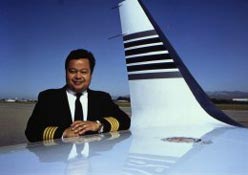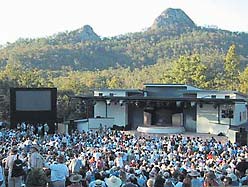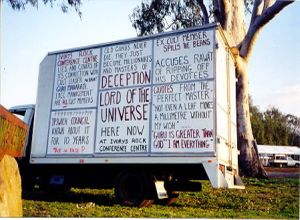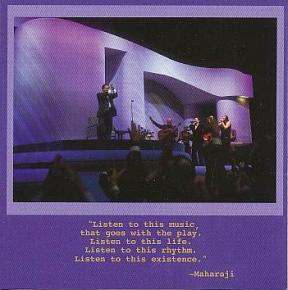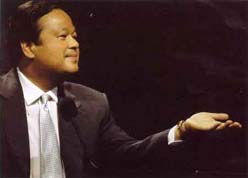Maharaji: Middle Age Revival
From 1976 onwards Prem Rawat was able to rely on the 'success' of his first five years in the west. The number of early recruits provided a resource large enough to keep the Mission operating and a few wealthy contributors kept Rawat in a style to which he was by then accustomed. The DECA project provided an effective fund raising model and Rawat's promotional activities increased during the 1980s in proportion to the growth of fund raising income. It was not however until the early 1990s that any significant reinvigoration of the 'mission' was attempted, when Rawat sought several costly transport and property acquisitions. The buying of planes and land was predicated on a re-commitment to an energetic propagation of the 'Knowledge' and the promise of a 'great leap forward' in the promotion of Rawat's message. These predictions and promises did not come to pass.
By the start of the 1990s, Maharaji's remaining followers, most now beginning middle age, were starting to yearn for the sense of engagement which had highlighted their early years with him. The decade began with a large fund-raising campaign to purchase Prem Rawat the jet aircraft he desired, the Challenger 610. US$4.5 million was raised in contributions from premies, plus US$3.2 million in loans (also from premies).
The early 1990s was also the time when Prem Rawat selected large tracts of rural land in Argentina and Australia for purchase and development. La Tierra del Amor ('the land of love') in Argentina, and Amaroo in southern Queensland, Australia, were intended, following planned million dollar investments, to serve as international meeting places.
The Argentine land proved to be a poor choice, and the final event there was washed out, amid general discomfort. Premies called it "La Tierra del Fango" (The Land of Mud). It was a flood area, bought because it was 'cheap'. In some places the mud was more than half way up to a person's knees. Rawat abandoned the project and never returned. However the Australian land - purchased in 1991 - proved viable, and by 1992 a conference centre was being developed at Amaroo.
Over the subsequent decade, hundreds of premies moved to the region from all over the world to help with the project. A beautifully finished hall (the 'Knowledge Hall') was built, seating 400. So was an outdoor amphitheatre for 4500, and office and bathroom blocks. Camping for several thousand people was established in a series of well-manicured campgrounds. Miles of roads, water, power and fibre optic cabling were installed.
Under its operational name of Ivory's Rock Conference Centre, Amaroo also served as an unsuccessful commercial conference centre for sporadic corporate and government clients.
International events were held at Amaroo for Maharaji's disciples, in 1994 and 1997, and also an 'Australasian' event in 1994. Attendance ranged from 1700 to 4600. The atmosphere at these events reprised a little of the 1970s spirit, though many attendees commented that it was a lot more rehearsed and less spontaneously joyous. Whereas in the 1970s premies had sung en masse to their master, led by an exuberant live band on-stage, now the band lip-synched songs pre-recorded and selected by Maharaji, to which the audience listened respectfully. Maharaji rather incongruously wore a business suit in the southern Queensland wilderness. For all this, many devotees left these events experiencing the old 'bliss', and with a renewed sense of commitment.
After the abandonment of the Argentine land, Amaroo became the number one project for Maharaji's western devotees. Amaroo's construction and infrastructure projects were funded by $US 10 million in unsecured loans raised from devotees. (Premie lenders were given a verbal promise that Rawat would personally repay them if the development was subsequently resold.)
A sceptical newspaper article published in Queensland's Brisbane Courier Mail in 1997 upset Prem Rawat, and he held no further international events at Amaroo for several years. Other stories followed over the years. He was probably more upset when Neville Ackland, a disillusioned but very energetic premie took the opportunity of staging a public protest which even had him interviewed on Australian television and the centre of newspaper articles.
The other major focus in the 1990s was the annual event celebrating Maharaji's birthday, held several years running in the Long Beach Auditorium in California. These events often drew
seven or eight thousand premies from all over the world.
Rawat travelled the world throughout the 1990s in private jets of increasing sophistication. These and other big ticket items, such as his mansions, luxury cars and small plane, helicopter and glider, were often purchased with the support of a group of about 400 'major donors': wealthy premies who
received preferential treatment at events, and greater access to Rawat, in return for substantial donations. These donations also contributed to the building of a new home
on the site of his old one at Malibu, valued at US$ 20 million.
As the technology became more readily available Maharaji instructed that his speeches be channelled into premies' homes, and small halls around the world, via satellite. By the end of the decade, satellite broadcasts were beginning to take over from video as the preferred medium for Rawat's discourses. My wife had a receiver installed in our home (Australia) and for a year or two a small group would gather on Sunday morning for the weekly hour long Elan Vital broadcast. I noticed that on this satellite TM© had a 7 days a week 24 hours a day broadcast as did Supreme Master Ching Hai.
The most significant 'institution' within Elan Vital toward the end of the 1990s was the week-long 'trainings'. These were teamwork education sessions conducted by Rawat himself, with the assistance of a handful of premie psychologists/trainers. Several people left Rawat as a result of the trainings, describing the experience as manipulative and emotionally abusive. There was no noticeable improvement in aspirant numbers in the years following.
Adherence numbers stabilised at the bottom end of the 1980s troughs. Attendance at international events gives some guide as to the decline that had occurred since the movement's heyday in the 1970s: That held at Amaroo, in 1997, drew just under 4600 people, whereas the events held at Kissimmee, Florida at the end of the 1970s had drawn 20,000. In Delhi, where Prem Rawat had once attracted a crowd of one million, he was drawing only about 70,000 people by the end of the 1990s but with significant technical and financial input was managing much larger crowds for special events after 2000 though only a quarter of what he had attracted 40 years before.
'Propagation' - the spreading of Rawat's message - continued but the exit of large numbers of premies, combined with the birth of the Internet, had brought about a vocal former follower movement. The first website critical of Prem Rawat - http://www.ex-premie.org/- appeared in 1997 and criticim of him has grown and become more sophisticated over the years.
Maharaji's cult compound in South East Queensland has provided regular stories for local newspapers over the years.
- Transport hoodoo, guru's only problem Courier-Mail, Brisbane, 27 April 2001
- Guru Inspires Prayer and Protest Courier Mail, Brisbane, Australia, March 9, 2002
- Guru goes to ground after security scare Courier Mail, Brisbane, Australia, July 9, 2002
- One Man's Guru Is Another Man's Fraud, or Worse Newsday (Melville, NY), October 21, 2001
- Blinded by the Light The Good Weekend, August 2, 2002
- Guru's followers flock to hear him speak Australian Associated Press, 4 September 2002
- Guru - mum's the word Gold Coast Bulletin, 4 September 2002
- Maharaji's inner peace in a tent doesn't come cheap Courier Mail, Brisbane, Australia, April 21, 2004.
- Peace at a price by Hedley Thomas, Courier Mail, Brisbane, Australia, April 24, 2004.
- Top dollar to see guru by Kay Dibben, Sunday Mail, The (Brisbane, Australia) - September 25, 2005
- Guru and devotees jet in for a Queensland love-in Courier Mail, September 14, 2012

